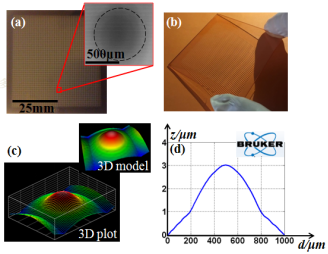Advances of IOE in Design and Fabricaiton of Multifocal Bionic Compound Eye Elements
With the rapid development of micro opto-electro-mechanical-system (MOEMS) technology, demands on the optical imaging systems are integrated, lightweight, wide fields of view (FOV), and high-sensitivities, such as navigation systems, wide angle micro-monitors, and endoscopes, which are increasing. The new bionic compound eye imaging system uses photoelectric elements to replace the corresponding structures in the insect compound eyes, which will revolutionarily improve the detection and sensing capabilities of the system, and provide new technologies for navigation systems, wide angle micro-monitors, and endoscopes.
One of the key elements of the bionic compound eye imaging system is a miniaturized and integrated optical element. By arranging the microlens arrays on the substrate to mimic biological compound eyes, a bionic compound eye optical element capable of capturing optical information in a large FOV and in different orientations is fabricated.
The focal length of the traditional microlens is unique, limiting the acquisition of image information during the optical imaging process. It seriously loses the targets information within different depths of field, leading to not detecte objects at different distances.Based on the conventional bionic compound eye structure, researchers from IOE designed a a multifocal bionic compound eye structure (MBCE) composed of individual lenses with multifocal points, which could capture optical information of objects at different depths. The MBEC element could form a integrated MOEMS imaging system connecting with the subsequent detection and circuit devices, providing new technology for large FOV imaging and high-precision positioning. This new technology does not involve expensive processing equipment and harsh experimental conditions. It is a low-cost and universal technology. The research on this project is potential to improve the our country’s fabrication level in the bionic compound eye field and lay a foundation for its further application.

Figure 1. The principle of the multifocal bionic compound eye (MBCE) (a) individual lenses arranged in an array; (b) diagram of imaging principle. The letter "F" is the object and it is imaged by the MBCE in different image planes including image plane 1 and image plane 2; (c) magnified picture of individual lens which has two different focal lengths.

Figure 2. The fabrication process flow (a) silica was chosen as the substrate; (b) photoresist was spin-coated on the silica; (c) moving exposure was carried out with gray-scale mask; (d) developing; (e) etching

Figure 3. Key fabrication results, including (a) gray-scale mask with an enlarged individual unit; (b) prototype based on silica; (c) 3D measurement of the fabricated MBCE structure by white light interferometer (d) surface profile measured by a step profilometer.
(Cao AXiu)
Contact
CAO Qiang
Institute of Optics and Electronics
Email: caoqiang@ioe.ac.cn
